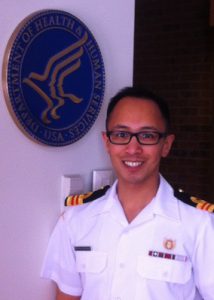By Vincent Beswick-Escanlar, MD, CCFP, Preventive Medicine Resident, Uniformed Services University, Bethesda, Maryland
 Thanks to the Association for Prevention Teaching and Research, I was selected for a 2 month rotation in public health policy in the Office of Disease Prevention and Health Promotion at the U.S. Department of Health and Human Services. Being a doctor in the Royal Canadian Medical Service, it’s a fantastic professional as well as cultural experience to contribute to the work of HHS. With the headquarters of the U.S. Public Health Service Commissioned Corps in the same building, my colleagues are used to seeing uniforms around the office, but it’s the “CANADA” badges on my shoulders that get a double-take. Though there are definitely a lot of differences in the way our countries approach health care, we share the same universal goal of improving the health of all people.
Thanks to the Association for Prevention Teaching and Research, I was selected for a 2 month rotation in public health policy in the Office of Disease Prevention and Health Promotion at the U.S. Department of Health and Human Services. Being a doctor in the Royal Canadian Medical Service, it’s a fantastic professional as well as cultural experience to contribute to the work of HHS. With the headquarters of the U.S. Public Health Service Commissioned Corps in the same building, my colleagues are used to seeing uniforms around the office, but it’s the “CANADA” badges on my shoulders that get a double-take. Though there are definitely a lot of differences in the way our countries approach health care, we share the same universal goal of improving the health of all people.
One example of a current public health issue that is a top priority on either side of the border relates to prescription opioids. Both the United States and Canada are facing a real epidemic in overdoses due to opioid misuse. We are the two largest per-capita consumers of prescription opioids in the world; together, we consume about 80 percent of the world’s opioids. In 2014, 28,000 Americans – that’s an average of 78 per day – died from an opioid overdose, a record high; similarly, more and more Canadians are dying every year. On both sides of the border, most of these deaths involved a prescription opioid.
Continuing education for medical providers is one way we might be able to improve opioid prescription practices, and in turn, reduce misuse and overdose deaths. By making sure that everyone who prescribes an opioid – doctors, dentists, nurse practitioners, physician assistants, and so on – has the training to decide when opioid medications should and shouldn’t be used, prescribers might be able to limit these drugs to only those patients who will therapeutically benefit from them, and avoid prescribing them when other pain management options might be more effective. It’s not just about finding the right drug and dose – it’s also about considering alternatives, dispensing just the right number of pills at a time, avoiding side effects, recognizing misuse, and so on. Although continuing education is not a replacement for foundational education – like at medical or nursing school – it might help prescribers stay up-to-date with the latest guidelines and best practices, as well as the needs of their communities.
One project I’m working on examines state requirements for continuing education that medical providers must have in order to prescribe opioid medications. I’m looking at legislation in every state to determine if medical providers need opioid-related continuing education to either prescribe opioids, or more generally to get a license to practice. There are a handful of states that do in fact have opioid-related continuing education requirements. For example, doctors in Massachusetts who prescribe controlled substances need opioid-related education credits every 2 years, while in Kentucky, providers who prescribe opioids must dedicate part of their required continuing education on their state’s electronic prescription monitoring program, addiction disorders, and pain management. However, most states, like Canadian provinces, don’t have any such rules – providers in these states might be required to have some kind of continuing education in general, but not necessarily around opioids.
Although it’s hard to say for sure that a requirement for opioid-related continuing education will reduce opioid misuse and overdose deaths, many professional organizations and government agencies agree that it makes sense that the people we trust to choose drugs wisely should have regular refreshers to make sure their knowledge and practice is up-to-date. The White House and 40 provider groups – representing doctors, dentists, nurse practitioners, and other professionals – are making opioid prescriber training a centerpiece of America’s plan to address the opioid epidemic. Prescriber training is also central to efforts led by HHS and Secretary Burwell to fight the opioid epidemic by reducing over-reliance on prescription opioid medications. For example, the recently released National Pain Strategy aims to improve education for health providers on pain management practices and alternatives to opioid-centric treatments. By knowing which states require opioid-specific continuing education and which ones don’t, we might be able to discover some best practices in getting the right training to the right people.
One such training, Pathways to Safer Opioid Use, is available through HHS at odphp.health.gov. This interactive, web-based eLearning course uses the principles of health literacy and a team-based approach to care to help doctors, nurses, pharmacists, and patients understand how to prevent opioid-related adverse drug events. ODPHP has partnered with the American Public Health Association to offer free continuing medical education credits for this course.
I’m glad to be a part of the ODPHP team at HHS and to have the opportunity to contribute to improving public health policy around prescription opioids here in the US – and I hope to apply what I’ve learned back in Canada when I return home.
Learn more about HHS policy, guidance, and training resources for safe opioid prescribing.